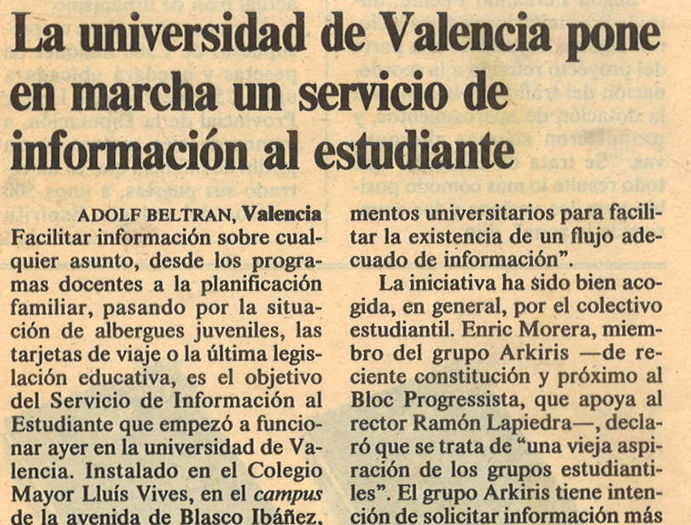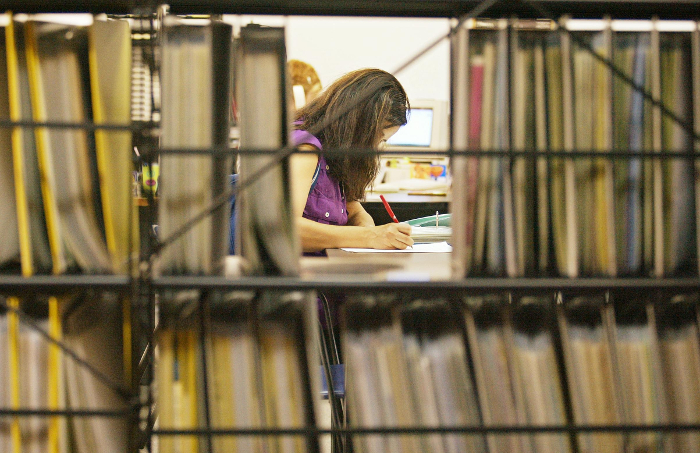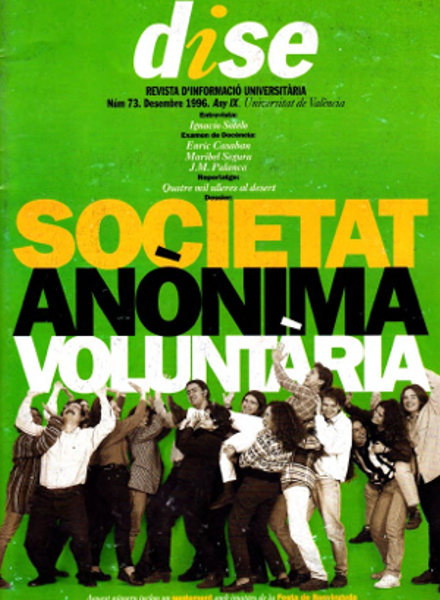
Introduction
Students are the core of this university and it is our priority objective to contribute to their intellectual, profesional, human, civic and cultural development.
The main purpose of the Information and Promotion Service (SEDI) is to provide the students - and future students - the resources available for them and to promote their participation. In order to achieve that, SEDI manages around 20 programmes which go from raising awareness of the Universitat to encouraging personal development, intellectual and social capacities.
SEDI has the following action areas:
INFORMATION AND ADVICE
It has three offices, one in each campus, where in-person information is provided. You can also contact us by telephone, email and social networks about the access to the Universitat de València, the offer of degrees and masters, complementary information, grants and aids, etc.
It organises the programme “Conèixer la Universitat” (Knowing the University): information programme for pre-universitary and pre-enrolled students, school counsellors and secondary education teachers. It includes an information day with the guiding counsellors, guided visits, printed informative material (guides, FUTURA magazine) and the Aprende y Emprende workshops.
PROMOTION
Besides, it arranges a series of programmes and initiatives:
- Mentoring (Entreiguals programme).
- Psychological, psychoeducative, legal and sexological advice (counselling).
- Formation in study skills (La Nau for students).
- Contemporary art (20th Mostra d’art públic / Universitat pública or Parlem d’art).
- Diversity (diversitades).
- Promotion of volunteering and cooperation (workshops and aids).
- Creative writing (writing workshops and writing awards).
- Supporting associativism and participation (census and aids).
- Mobility support (traveling aids).
The perspective of these initiatives is not vertical: the objective of these programmes is the active participation and involvement of the student. SEDI provides the tools, but the students carry out the activities.
Therefore, SEDI is more than an information and promotion centre: it is also a management centre in charge of organising these activities.

Of course, SEDI has his own history. In 1987, 30 years ago, it was born as DISE (Dissemination, Information and Services for the Students). Afterwards, with the cooperation of the Vice-Rectorate for the Students, in 1998 CADE was founded (Counselling and Promotion Centre for the Students). It began to manage some of the programmes that until that moment used to be in charge of the DISE and started creating new programmes as well.
DISE was initially conceived as a university information centre. Its mission was to achieve two goals: to get the university to meet the demands of the users and to provide these users the means to confection their own curriculums.
This is the reason why DISE was defined as an information centre for the students. Besides, the students participated in the creation of the service. With the entry into force of the Universitat de València Statutes, passed in 1985, the students achieved a 27% representation in the University Senate and also in all the governing bodies of the university. In this context was born DISE, as a demand of the students for more services capable of meeting their needs.
Finally, in 2011, DISE and CASE became an only service currently known as SEDI: Information and Promotion Service for the Students. As a result, it has turned into an integrative management centre at the service of the students.

It should be highlighted the namesake magazine published by the DISE, with a trajectory of 10 years (1987-1997). Monthly published, DISE was a magazine made for the students, where they were informed about the university present. Grants’ dossiers, courses and acommodation offers were attached, and they were kept updated about the latest cultural news as well. In fact, the magazine included all the news regarding the university, as well as the social environment of the students. Important public figures such as Joan Fuster, James Casey and Jürgen Habermas appeared in the magazine. This attempt to develop an interactive and informative culture involved the user into the searching of information, which promoted the individual consult of primary, secondary and electronic sources. This was a characteristic that differentiated the DISE from other public services of information.

Services like DISE have been fundamental, as they have encouraged the improvement of the living standards of the students at the Universitat de València. These services cover a wide range of needs, but they also collaborated to the cohesion and social instauration of the university community, promoting the relation between the students and the institution.
The main objective of this exhibition is to provide visibility to the Information and Promotion Service of the Universitat de València, which has a fundamental role in informing the students about the grants or complementary information and also managing a series of cultural activities carried out in the university. However, as we have previosly mentioned, this service would be meaningless without the participation of the students. They are the principal focus of the exhibition: they will appear in the images and will be in charge of telling what the SEDI has represented for them in their university lifes. SEDI is a service that kept and keeps the students updated, more active, more participative, more universitary, definitely: in the sense less academic on more vital of the word.












